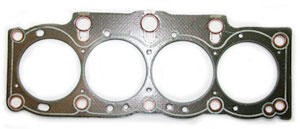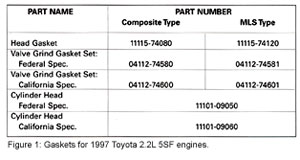 Loss of engine coolant has been reported on some Toyota 2.2L 5SFE engines in various amounts. In most cases, there are limited signs of this leakage on the ground directly below the engine compartment after it has set for a long period of time.
Loss of engine coolant has been reported on some Toyota 2.2L 5SFE engines in various amounts. In most cases, there are limited signs of this leakage on the ground directly below the engine compartment after it has set for a long period of time.
Depending on the production date code of the engine stamped on the front of the cylinder head, two types of head gaskets are used. Use a composite-type gasket (p/n 11115-74081) if engine number is lower than 5985000. Use an MLS (multi-layer steel) gasket (p/n 11115-74120) if the engine number is 5985000 or higher.
It is important to use the correct style head gasket in attempts to seal this type of coolant leakage. The mounting bolt torque for both style gaskets is the same, 36 ft.lbs. plus an additional 90° turn.

In addition to gasket style, caution should be used when ordering replacement cylinder heads and gasket sets because California and Federal part numbers are different.
If the cylinder head is being replaced, it is important to use parts manufactured after 8/4/1997.
Tech Tip courtesy of ENGINE BUILDER magazine.













